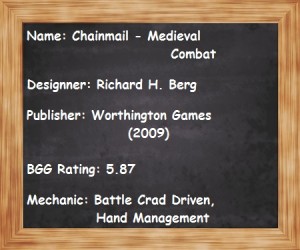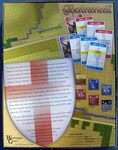Chainmail – First Impressions
Designer: Richard Berg
Publisher: Worthington Games (2009)
 [Chainmail: Medieval Combat should not be confused with the game Chainmail, the miniatures game created by Gary Gygax in 1971. Richard Berg’s game covers the battles of Legnano (1176), Bouvines (1214), Lewes (1264), and Bannockburn (1314). – ED]
[Chainmail: Medieval Combat should not be confused with the game Chainmail, the miniatures game created by Gary Gygax in 1971. Richard Berg’s game covers the battles of Legnano (1176), Bouvines (1214), Lewes (1264), and Bannockburn (1314). – ED]
Having played quite a bit of “Manuever” with my opponent, we looked that the descriptions of this game and decided that it would offer us something that was a bit more of an historical simulation. The rules are short and concise, the game was pretty quick to set up and get right into playing. We decided we would document and deal with any rule or play issues that came up as we went along. There were few, most of them answered by the examples of play in the rules.
One oddity about the counters, at least mine. As with all of the counters in games like this, the two sides of the counter-sheets are different. The top side where the counters are ‘punched’ are usually used as the front of the counter sheet. In my game one of the sheets had the stronger counter on the ‘front’, but the other two have the reduced strength counter on what is usually punched as the front. Since the reduced strength value is a different color it has no effect at all on play. Just something unusual.
There are four scenarios in the game, each with a unique set of counters. The game boards for all four scenarios are on a single 34″ x 22″ backprinted mapsheet, two on each side. Each side has the mapsheet for two of the battles. The play areas for the scenarios are different sizes, so we ended up adding folds to the map since our gaming area isn’t quite large enough to layout the entire map.
 There are two decks of cards, one of 38 cards and one of 40 cards. Not all cards are used in every scenario, and some cards included in a scenario may have an event that is not applicable to that scenario. The composition of each players deck in both total number of cards and the exact cards used are unique for each scenario, which defines what each side may be capable of doing (or not) in a given scenario. At the start of each turn the players shuffle all the cards in their deck that are being used for the scenario and deal a set number of cards as their hand. So while you may know what cards a player has in his deck you can’t be sure what they have in their hand on any given turn. Deck size varies from 18 cards to 28 cards and hand size varies from 11 cards to 16 cards, so you usually you start with just over half of the cards for that scenario in your hand.
There are two decks of cards, one of 38 cards and one of 40 cards. Not all cards are used in every scenario, and some cards included in a scenario may have an event that is not applicable to that scenario. The composition of each players deck in both total number of cards and the exact cards used are unique for each scenario, which defines what each side may be capable of doing (or not) in a given scenario. At the start of each turn the players shuffle all the cards in their deck that are being used for the scenario and deal a set number of cards as their hand. So while you may know what cards a player has in his deck you can’t be sure what they have in their hand on any given turn. Deck size varies from 18 cards to 28 cards and hand size varies from 11 cards to 16 cards, so you usually you start with just over half of the cards for that scenario in your hand.
THE BATTLE OF LEGNANO
Italy, May 29, 1176
The Holy Roman Empire, under Frederick I Barbarossa vs The Lombard League, under Alberto da Giussano
We start with what is listed as the first scenario, the battle of Legnano. The Holy Roman Empire (Blue) will battle the Lombard League (Red). The numbers favor the Lombards, but the HRE player has some advantages. Victory is achieved for the Lombard by eliminating 25 battle points of HRE units, while the HRE player must eliminate 30 points of Lombard units. The Lombard pikemen may not come into play at all if the HRE player can achieve enough VPs by eliminating the Lombard knights.
 Let’s walk through one player round of one of our early attempts at playing the game, just to show some of the decisions that are made each round. While the active player is limited to playing no more than 5 cards in a round, experience has shown that it is usually a bad idea to play that many cards unless you have a sizeable card advantage. Both sides start with 12 cards, Lombard League has initiative and decides to go first.
Let’s walk through one player round of one of our early attempts at playing the game, just to show some of the decisions that are made each round. While the active player is limited to playing no more than 5 cards in a round, experience has shown that it is usually a bad idea to play that many cards unless you have a sizeable card advantage. Both sides start with 12 cards, Lombard League has initiative and decides to go first.
I play my first card for movement points and move to flank attack the already reduced knight on the right flank. The knight that moved (marked “Used”) and attacking the flank is doubled for 8 BPs and the knight making the frontal attack adds 4 more BPs so the battle starts at 12 BPs vs 2 BPs.
Since most of the cards add between 2 and 3 battle points (BPs), the HRE would have to play at least 2 cards to get the 5 additional BPs required to save the knight from a 2:1 battle ratio that would eliminate it.
Neither side plays cards and the HRE knight becomes the first unit eliminated. The knight attacking head on to the north advances into the hex and the flanking knight changes facing to align with the rest of the Lombard knights. Both are marked as “Used” since they moved or attacked and while they no longer move this round they may still make attacks.
I play my 2nd card to move the Milan knight to flank the HRE 3 knight and declare that both knights will attack. This gives me 9 BPs to 4 BPs and I anticipate that the HRE will play a card to get the odds down to less than 2:1 so the knight can retreat without loss.
Instead, he plays a “Counter Attack” event and cancels the flank attack of the Milan 7 knight. The other knight must still make the frontal attack alone at 3:4. If the defender can achieve a 2:1 advantage in BPs, the attacking unit is reduced. I don’t want to run the risk of him playing a BP 2 card to reduce my knight, so I play a BP 2 card of my own (my 3rd card play of the round) to raise my strength to ‘5’. The HRE plays no cards and retreats his knight back one space and continues to face him South.
My knight must advance into the space and while it could change facing it does not.
The HRE Counter Attack is now executed. He may designate any unit as making the counter-attack, although he could declare none and not make any attack, and move that unit up to 2 MPs to make the attack. the HRE 4 knight advances 1 space to take the Milan 7 knight in the flank.
The initial odds are 8:3. I only have two card plays left for this round and don’t want to use one here, so I accept the >2:1 defeat, reduce the Milan 7 knight and retreat south, changing facing to the North after the retreat. The HRE knight must advance into the space and retains its facing.
All victorious units in a battle may freely change facing after the battle is resolved. Any unit that retreats as a result of battle may freely change facing after conducting the retreat. Many times the decision of which direction to face after the battle is the most important one you will make for that battle.
I play my 4th card for this round for movement and bring up the Milan 5 knight to attack the HRE 3 knight in the flank. The “Used” unit can join combat again, so I attack with both units giving me a total of 11:4 on battle points. I expect my opponent to use a BP2 card to avoid the 2:1 loss + retreat.
He plays ANOTHER Counter Attack event. He has two in his deck and he just happened to have both of them this hand. He again cancels the attack of the flanking knight and I am faced with a 3:4 frontal attack again, as well as the follow up counterattack and I am only allowed to play one more card this round!
I decide to play a BP2 card as my 5th and final card for the round in this battle to raise the ratio to 5:4. The HRE player again declines to play any cards and I win the battle. The HRE knight retreats one space and I advance. I can play no more cards this round.
The HRE knight that conducted the first counter attack now uses the 2MP allowed by the event to “about face” and take the Milan 5 knight in the flank. The ratio is 8:4 and I cannot play any more cards, so the knight is reduced and retreats West (down in the picture), changing facing to the north after the retreat.
The HRE knight advances into the space and does another about face to face South. That round didn’t go well at all.
It is now the Holy Emperor’s round and he can play up to 5 cards. He starts his round by playing two cards for a total of 13 movement points. His knights move in several directions, setting up for many attacks.
The general rule is that you may only declare one battle each time you play a card as the event or for movement points. The HRE could have played one card for MPs and made an attack, then the second card for MPs and made another attack. The reason for playing two cards for movement is that a knight or cavalry unit may want to spend more MPs on a single move than one card allows. By playing two cards for movement he can gain enough MPs to move the knight where it wants to go by adding the MPs from two cards. This option is not available to infantry units, which can never spend more MPs in one move than the MP value of one card.
At his point the HRE player could have declared a single battle, but he got carried away because he wanted to play his third card for the event, a “Multiple Attack” event. This allows him to conduct as many battles has he wishes from the current position. He declares all the battles he wishes to fight, designating which units are involved in each attack and defense. No unit may be involved in more than one battle. In fact, a battle may only target a single defending unit.
The Emperor conducts his battles in order from left to right in the picture. The initial attack is two knights against the reduced knight in space I5. The starting battle odds are 11:2. The Lombard player must add 4 battle points to raise the total to 6 to avoid the 2:1 result so the unit will survive to retreat. A single card worth 4 battle points is played for the Lombard, while the HRE player (who has already played 3 cards this round) declines to add any. The reduced knight retreats and the knight making the frontal attack advances, then both attacking knights are turned to face the front.
The ‘5’ knight in H9 then makes an attack into the rear facing of the ‘4’ knight in G9. The HRE now plays the “Elite Bonus” event, which doubles the value of his elite units in the battle. The Elite knight is now doubled to a BP value of 10, then tripled for attacking the defender in the rear for a total of 30 BPs. At 30:4 it would require way too many cards to save the unit, so both players decline to play an cards in the battle and the knight is reduced and retreated to the left. The attacking knight now enters the space and turns 180 degrees to face the space he entered the hex from.
The Emperor himself now leads a frontal attack against a ‘4’ knight. He adds his 2 factors to the 5 BPs of the knight to achieve a 7:4 ratio against the defender. If the HRE player adds a card to this battle he can achieve the 2:1 odds necessary to incur a step loss and retreat on the defender. The Lombard player gambles that the Emperor will not play his 5th and final card for the round for this battle. Neither side plays any cards, so the defending knight retreats and the attacking knight moves into the space and turns to face the knight that just retreated.
Finally, on the extreme right of the line there is a ‘4’ knight making a flank attack for an initial ratio of 2:1. The Lombard player plays a 2 BP card to raise his point total to 6, but he is foiled by the HRE play of a 4 BP card to raise his total to 12. The 2:1 ratio causes the Lombard knight to take a step loss and retreat and the victorious HRE knight advances into the space and turns to face the defeated knight. The HRE player has played all 5 of his cards and his round is over.
 We have played the game a couple of times now. The most recent game represents our current lessons from the first scenario. After looking at the cards we can see that what applies to this scenario may not apply to others since the deck construction defines what is possible. The Holy Roman Empire (Blue) has several powerful cards which offset the numerical advantage of the Lombard League. In fact, until the HRE moves to engage the pikemen, there are very few events the Lombard player wants to use. Most his cards will be played for MPs and BPs.
We have played the game a couple of times now. The most recent game represents our current lessons from the first scenario. After looking at the cards we can see that what applies to this scenario may not apply to others since the deck construction defines what is possible. The Holy Roman Empire (Blue) has several powerful cards which offset the numerical advantage of the Lombard League. In fact, until the HRE moves to engage the pikemen, there are very few events the Lombard player wants to use. Most his cards will be played for MPs and BPs.
The two pictures show the position at the start of turn 3 and turn 5. You will notice that not much has changed. I advanced the Lombard knights adjacent to the HRE line to prevent the play of the “Knights Charge” event. The HRE player can play this event to advance a knight straight ahead and attack at 2x strength. This is a powerful attack and the Lombard player must either accept the step loss and retreat, or play a battle card to limit the damage to simply a retreat. The attacking knight can advance, then turn to flank another enemy knight to support the attack of another unit along the line. With the play of two or three cards for MPs and the associated attacks, the HRE can put a lot of pressure at any point in the line.
This game is all about the management of your hand to secure an advantage there that can be translated to an advantage on the battle field. The side with more cards at the end of the turn has the initiative. The objective is to use cards in a way that compels your opponent to either accept step losses and retreats or play even more cards to save his units. At the end of the turn you make attacks where the defender must accept losses, then gain the initiative at the start of next turn to follow up. This can create a situation where the other sides position falls apart.
We soon realized that any plan that requires playing four or five cards in the early part of the turn is a bad plan. If you can’t make your opponent use cards in defense, he can simply play one card then end his round and send it back to you. At the end of the turn you will find yourself “passing” just to save a card or two for defense in case your opponent has a big ending planned.
Here are what we consider to be the key event cards in the deck.
1 – Counter-Attack (HRE only). He has two of them and they can quickly cause problems for the Lombard. Consider the situation in the “Start turn 5” position above. The ‘4’ knight on the extreme right of the Lombard Line could spend 4 MPs to turn, move into the woods, turn again and flank the HRE ‘3’ knight. If the pikeman joins this attack the Lombard player has 10 BPs attacking 3 BPs and the unit is surrounded without a retreat. The HRE player MUST play at least a 3 BP to raise his total to 6 to avoid the elimination of the knight. He needs to consider that that Lombard player may add additional BPs to the battle and still eliminate the unit. But, if he plays a Counter Attack event the tables are turned! He cancels the attack of the knight and now the pikeman is attacking alone at a 2-3 disadvantage. If the HRE player commits a card to defense now, the Lombard pikemen will take a step loss if the defender gains a 2:1 advantage in BPs. This battle will be followed by the HRE ‘4’ knight moving ahead one space and turning to flank the Lombard ‘4 knight, gaining an 8:5 BP advantage. Again, the Lombard player will need to add some BPs to that battle or risk the reduction of his knight and the advance of the HRE knight into the woods. Talk about one card turning it around!
2 – Multiple Attacks (2x for the HRE, 1x for the Lombard). This event can be a game breaker if played at the end of the turn when your opponent is out of cards. In fact, most of our turn is spent attempting to achieve an end turn position where you have a high MP card and this event is handy when your opponent is out of cards. You then move to set up as many 2:1 attacks as possible with the MPs and play the event to reduce and retreat all the attacked units. If this can be achieved the turn usually ends with the advantage player using a ‘4’ knight to flank attack an opponents ‘4’ knight as part of the MP card play and attacking to reduce and retreat the unit with the victor advancing into the space. He then plays the Multiple Attack event to have the ‘4’ knight now make a frontal assault on the same target knight that is now reduced to a ‘2’ and eliminating it.
3 – Rally (each side has 2). Sometimes you need this event to save a reduced unit that is under pressure. The best time to play it is after you have used a MP card to move units into position to make 2 attacks. You resolve the 1st attack as your allowed attack for the play of the MP card, then rally a unit and follow that with your 2nd attack. It is usually used to rally a ‘2’ knight facing a ‘4’ knight before your opponent has the opportunity to make the 4:2 attack.
4 – Cavalry Returns (each side has 2). There are times when a knight is surrounded and being attacked at terrific odds. In the Turn 5 picture, the HRE player has the initiative and played a MP 6 card to surround the Lombard knight in the woods on the extreme left of the Lombard line and attack at 14:5. The Lombard player must add at least a BP 3 card to the battle to avoid the elimination of the knight, and this assumes the HRE player does not add a BP 2 card to his attack. It’s best to simply not play a card and let the unit be eliminated, then use this event to return him to the game. The backward knight in that same picture coming up on the Lombard left is one such knight returning to the battle. The down side of this event card is that you must also play a card for MPs before you play this event to return the knight to battle. That means parting with two cards, but you do need to keep those units out of the eliminated box.
5 – Knights Charge (HRE has several, Lombard has none). With the play of this event a knight moves 1 or 2 spaces directly ahead and attacks his target with double BPs. If he hits the target in the flank his BPs are quadrupled. A ‘4 knight charging a ‘4’ knight in the flank is a 16:4 battle and there is little chance the Lombard is going to add the 5 BPs necessary to prevent the step loss and retreat. All that for one card. A powerful card that the Lombard cannot counter.
There are several events in the Lombard deck that apply to the pikemen, but they rarely came into play in our games. The HRE was usually able to secure enough VPs from a broken Lombard line that he didn’t need to engage the main line of pikemen. I did move a few pikemen up to lengthen the line and support the knights, but they rarely needed any events to support their defense. They did draw a fair number of Rally events, since they don’t return once eliminated. I tried to keep them close to the woods.
The jury is still out on the most effective combat formations. As you can see from the pictures, both of us currently favor a solid front line. The most serious weakness of this formation is that two of the four spaces adjacent to your units are occupied with friendly units. Once a unit can get behind the line, any unit attacked from the front and the rear is in deep trouble, as it has no retreat. The ‘staggered’ line, where the units line up along a diagonal, open up all four spaces adjacent to a unit, but give the opponent additional attacking positions. This may work well for the HRE player, where the Lombard risks a Counter-Attack event if he attempts to exploit that fact. My feeling is that longer lines where the flanks are secure work best with the straight line of units, while smaller formations of five or six units may be better served with a diagonal formation with units behind it to replace units that are driven off their position.
After playing the scenario a couple of times, we are moving on to the Bouvines scenario. A review and discussion of that scenario can be found at the link below.
Here are the answers to some of the questions we had for the designer.
If an infantry unit that is part of the shield wall retreats as a result of combat, Does it retain or lose the shield wall status?
It loses that status. . .
Do Knight units that return to the battle (from the eliminated units) count for Victory Points?
No . . .they are no longer eliminated.
May a player play two Elite Bonus events for the same battle to quadruple the combat factor of elite units?
The rules don’t say No, but i think they should . . . no doubling of elite cards.
After playing a card for movement points, are you permitted to conduct a regular attack prior to playing the “Multiple Attack” event?
Yes . . . but you have to play another card first to get the ability to use that Multiple Attack card.
After playing the “Multiple Attack” event, do you declare all the attacks you wish to make immediately, or do you declare and resolve them one at a time?
Declare all immediately, and resolve in order you wish.
A Multiple Attack event is played and the battles declared. As the first battle is resolved, the defender plays a “Counter Attack” event. May he use one of the units that was declared as the target of a different battle to counter-attack?
No.
The attacker plays his 5th card for MPs, then declares a battle. The opponent plays his last card for BPs and is out of cards. Is the turn over, or does the attacker get another round with his remaining cards? What happens if the defender plays his last card for BPs and the attacker has only played 3 cards? Does the turn end after he plays two more cards, or can he declare his round over and start a new round with a 5 card limit?
The attacker can finish his Round as he pleases . . . play passes to the cardless defender (who must pass) and then back to the Attacker, who then gets one last round.
A unit does not move, but is declared as an attacking unit. A Counter-Attack event cancels his attack. Is that unit still considered “Used” for the round?
No.
Game Resources:









